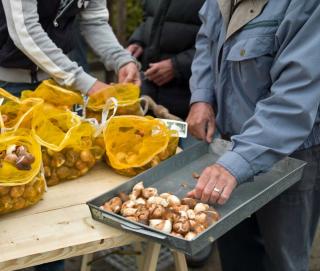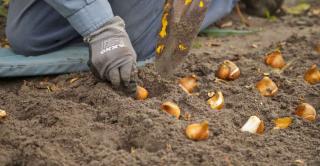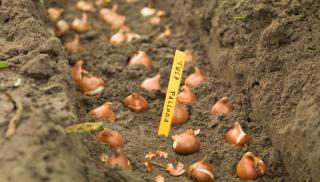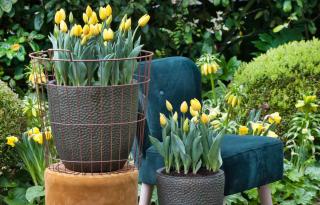

Planting a tulip is a common operation, both in the garden and in pots.
It goes without saying that with the many splendid varieties and its ease of care, it’s one of the most famous and appreciated flower bulbs of all! Make the most of the tulip’s spring blooming by following the planting guide below.
The entire Tulipa genus, part of the Liliaceae family, numbers over 120 different species fully set to decorate gardens, decks and balconies. Simple or double, single-colored, bicolored and even three-colored… Tulip will fit with everyone’s tastes.
For the planting of tulip bulbs , the best season is fall, anytime from October to December, on days without frost. Ideal, however, is to plant at the beginning of fall so that roots can develop: this triggers earlier blooming in the following spring.
 Even though fall bulbs usually are pretty hardy, in some cases conditions are harsher than what they can take. In case of long-lasting bouts of freezing, it’s best to protect your tulips with a thick layer of mulch or some layers of horticultural fleece.
Even though fall bulbs usually are pretty hardy, in some cases conditions are harsher than what they can take. In case of long-lasting bouts of freezing, it’s best to protect your tulips with a thick layer of mulch or some layers of horticultural fleece.
To extend the blooming of your tulips till the end of spring, go ahead and plant new bulbs every two weeks. This will lead to new flowers opening up as older tulips start to wither.
If your garden is run over with rodents, protect your bulbs with mesh wire or nets.
Tulips particularly love sunny spots, which make their blooming richer. They’re also well-suited to partly sunny spots. You should know that since each bulb needs 4 to 6 inches of free space around it (10 to 15 cm), the garden bed you’re planting them in should be large enough.
 For starters, prepare the planting soil for your tulips. This crucial step is what will allow your bulbs to send out better roots, directly influencing the quality of the blooming. Loosen up the soil and break up clumps. Then, remove any roots, rocks, and weeds you find.
For starters, prepare the planting soil for your tulips. This crucial step is what will allow your bulbs to send out better roots, directly influencing the quality of the blooming. Loosen up the soil and break up clumps. Then, remove any roots, rocks, and weeds you find.
Once that’s done, the soil should be light and homogenous, which helps drainage. When you’re dealing with heavy or clayish soil, add sand to the planting soil to lighten it up.
 Settle your bulbs with the tip pointing upwards, 4 or 6 inches deep (10 or 15 cm), depending on their caliber. Most tulip varieties require planting at a depth of 3 times the height of the bulb. Also, make sure you get the tulip bulb spacing right: around 4 inches (10 cm).
Settle your bulbs with the tip pointing upwards, 4 or 6 inches deep (10 or 15 cm), depending on their caliber. Most tulip varieties require planting at a depth of 3 times the height of the bulb. Also, make sure you get the tulip bulb spacing right: around 4 inches (10 cm).
Tip: get your hands on bulb planters that are perfect to make this step a cinch.
To increase tulip growth and blooming, go ahead and drop a handful of soil mix at the bottom of the planting hole. Are your bulbs in place yet? Then cover them with soil mix and water, but not a lot. Mulch the surface of the soil to protect the bulbs from low temperatures.
 Short-stemmed tulips will adjust very well to growing in a pot or a garden box. The container must simply have a drainage hole to ensure excess water drains away, otherwise the bulbs will rot.
Short-stemmed tulips will adjust very well to growing in a pot or a garden box. The container must simply have a drainage hole to ensure excess water drains away, otherwise the bulbs will rot.
Planting tulips in pots requires substrate that has clay pebbles or gravel mixed in together with bulb flower soil mix.
As is done when planting directly in the ground, the bulb is placed with the tip facing up, 4 inches deep and 4 inches apart from other bulbs (10 cm). Some varieties are clearly better than others for growing in pots. Botanical tulips are examples of this.
To learn more: